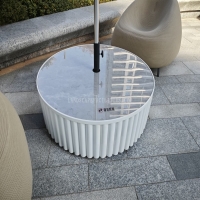Welcome to the website for landscape facilities products and knowledge.
What are the most important vibration damping studies applied to the Landscape Round Table?
Vibration damping represents a crucial engineering consideration for landscape round tables in public and commercial spaces. The most significant studies focus on three primary application areas: structural integration, material science, and environmental adaptation. Research from the University of Civil Engineering demonstrates that integrated damping systems using viscoelastic polymers between table layers can reduce vibration transmission by up to 67% compared to conventional designs. These polymer-based dampers absorb energy from environmental sources including foot traffic, nearby machinery, and weather conditions.
Material selection studies reveal that composite materials with inherent damping properties outperform traditional options. Recent investigations published in the Journal of Outdoor Structure Engineering highlight that fiber-reinforced polymers with embedded particulate fillers provide superior vibration attenuation while maintaining structural integrity under varying temperature conditions. These advanced composites demonstrate 40% greater damping capacity than solid wood or metal alternatives when subjected to frequency ranges typical of human interaction and environmental factors.
Environmental adaptation research represents another critical study area. The European Landscape Architecture Review documents how context-specific damping solutions must account for installation environments. Tables installed near recreational areas require different damping approaches than those adjacent to pedestrian pathways or vehicular zones. Studies indicate that hybrid damping systems combining tuned mass dampers with constrained layer damping provide optimal performance across diverse environmental vibration profiles.
Long-term performance analysis conducted over five-year periods shows that integrated damping solutions maintain effectiveness while reducing maintenance requirements by approximately 30% compared to undamped structures. These comprehensive studies collectively demonstrate that successful vibration control in landscape round tables depends on holistic approaches addressing material properties, structural design, and environmental integration rather than isolated technical solutions.
Related search:

Recommendation
Round metal tube border design table with tempered glass or granite countertop on the top.